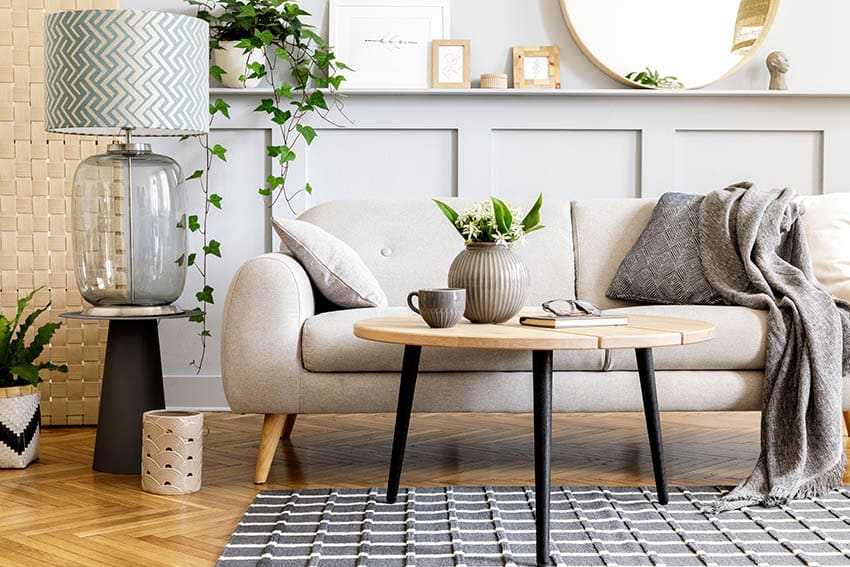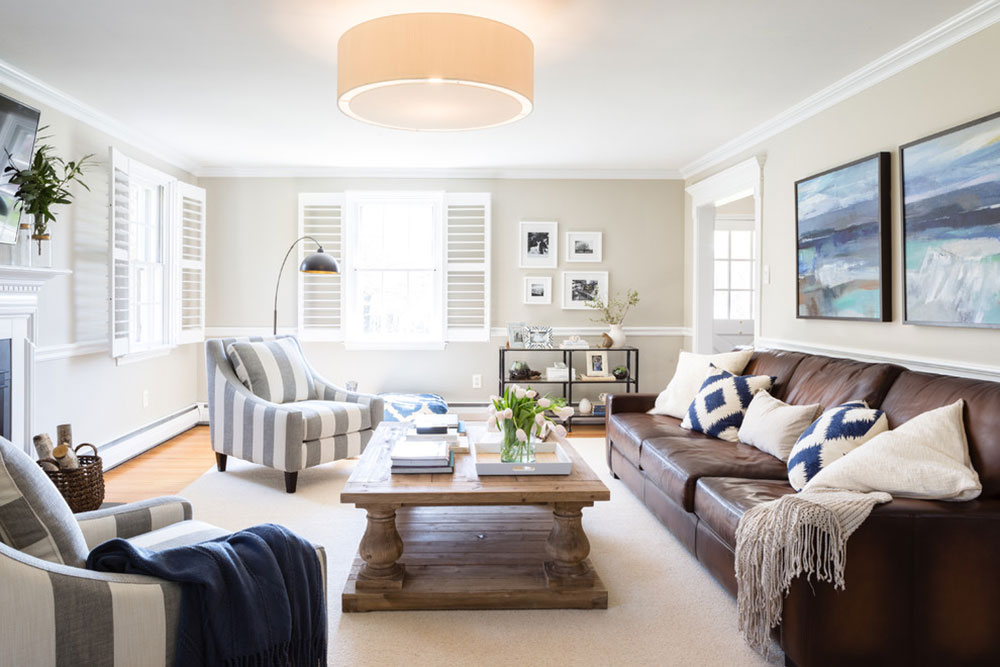Lighting is one of the most important factors when it comes to creating a comfortable and inviting living room space. But if you have no overhead lighting in your living room, how do you add light to these otherwise dark rooms? In this guide, we will explore some of the best ways to light up your living room with no overhead lighting.
How do you light a whole living room without overhead lighting?
There are a number of ways to light up a living room without overhead lighting. One way is to use lamps. Lamps come in all shapes and sizes and can be placed on end tables, coffee tables, or even the floor. Bring in all of the natural light you can. If you have large windows, open up the curtains or blinds to let in as much natural light as possible. This will help brighten up the room and make it feel more open and inviting.
Use recessed lighting. Recessed lighting is a type of lighting that is installed on the ceiling. These lights are ideal for living rooms because they provide gentle, diffused light that can be directed where it is needed most. Add a floor lamp. Floor lamps are another great way to add light to a living room without overhead lighting. These lamps can be placed in corners or next to sofas and chairs to provide reading light or general ambient light.
Hanging string lights or fairy lights can also be a great way to light up a living room without overhead lighting. These lights are easy to install, and they can create a festive or romantic atmosphere in your living room. Plug-in wall sconces are another great option for adding light without overhead lighting. These lights are easy to install and can be moved around the room as needed.
Add more light with mirrors. Mirrors reflect light and can make a room feel brighter and more open. Hang a mirror on the wall or place a large mirror on the floor to reflect light from lamps or windows. Paint your walls a lighter color. Dark colors tend to make rooms feel smaller and more closed in. Choose lighter colors for your walls to help brighten up the space.
Table lamps are also a great way to light up a living room with no overhead lighting. These lamps can be placed on end tables, coffee tables, or side tables. They provide both ambient light and task lighting, making them a versatile option for any living room.
You can consider plug-in pendant light fixtures as well. These fixtures are perfect for living rooms that have high ceilings, as they can add a dramatic and eye-catching look to your space. Flameless candles are another great way to add light to a living room without overhead lighting. These candles are safe to use and can be placed on shelves, mantles, or coffee tables. They provide a warm, inviting glow that can make any living room feel more welcoming.
No matter what type of living room you have, there are a number of ways to add light without overhead lighting. By using lamps, natural light, recessed lighting, floor lamps, string lights, plug-in wall sconces, mirrors, table lamps, pendant light fixtures, flameless candles, or a combination of these options, you can create a bright and inviting space that your family and friends will love.

How can I add light to a living room without wiring?
There are several lighting ideas without wiring that may easily modify the appearance and feel of your living area. To begin, consider something basic, such as upgrading your light bulbs or lampshades. Higher-quality light bulbs and lampshades typically cast brighter, more appealing light patterns.
Another option is to use floor lamps or table lamps to create ambient lighting throughout your living space. These lights can be moved around as needed, making them a versatile lighting option that won't require any wiring or installation.
For added brightness without the need for wiring, you may also consider adding mirrors or reflective surfaces to your living room walls or floors. Mirrors naturally reflect light and can help brighten up even the darkest rooms.
Pendant lights with a plug-in design are another lighting option that does not require any wiring. These fixtures are a great choice for high-ceilinged living rooms, as they can add elegance and dimension to the space.
Additionally, flameless candles are a simple way to light up your room without the need for wires or installation. Flickering battery-operated candles provide a warm and inviting glow that is ideal for creating a relaxing atmosphere in your living room.
Sconces for the wall that look like standard light fixtures are another great battery-operated option for living rooms that don't have overhead lighting. These sconces are easy to install and can be placed on either side of your fireplace or television for a balanced look.
Wifi ceiling fan light bulbs and motion sensor lighting are other options that can help brighten up your living room without the need for any wiring. By using any combination of these tips, you can easily create a bright and inviting space in your living room without the hassle of installing wiring or other electrical components.
Why do living rooms not have overhead lights?
Ceiling lights are required in certain rooms for a variety of reasons, the most common being that installing a plug-lamp would be impractical. Can you picture fitting a plug-in lamp in your kitchen or bathroom? It would be chaotic and cause too much clutter. There are other rooms in your home, however, where having a ceiling light would make perfect sense – like the living room.
The living room is one of the most important rooms in your house. It’s where you entertain guests, spend time with family, and relax after a long day. Therefore, it should be well-lit so that you can properly enjoy all it has to offer. But what if your living room doesn’t have any overhead lighting?
There are a few things you can do to light up your living room without resorting to installing a ceiling light. The first is to make use of natural light by opening up your curtains or blinds during the daytime. If you have large windows, this is especially important since your room will be flooded with sunlight. Another option is to use lamps throughout the room, perhaps on each side table or by your couch and chairs. You could also invest in a floor lamp to add some extra lighting without taking up too much space.
Alternatively, you may choose to mount wall sconces around the perimeter of your living room so that there’s plenty of light no matter where you are seated. This is a good choice if you want to minimize clutter and keep your living room looking clean and tidy.
Should a living room have a ceiling light?
Modern living rooms are quite bright, so don't forget to dress warmly. Modern living rooms do not require much light, as many individuals like to up-light the ceiling with a continuous LED lighting strip to provide an overall glow that may be used for mood lighting. People prefer recessed lights, such as WAC's LED212E, such as table surfaces, fireplaces, and art for directed illumination. You can also use a corner or indirect lighting, such as wall-mounted uplights that cast light onto the ceiling.
If you are looking to create a living room with no overhead lighting, there are many different options to consider. One popular option is to install recessed lights along the floor and walls of your living room, which can provide bright, directed illumination for your space. Additionally, you may want to utilize ambient lighting techniques like table lamps and floor lamps that can help create a warm glow throughout your living room.
Another option for lighting a living room without overhead fixtures is to install wall sconces or up-lights in strategic locations around the room. These types of lights are ideal for highlighting specific elements within your living room, and can also be used to create calming or dramatic mood lighting.

Ultimately, the best way to light a living room without overhead fixtures is to consider the layout and design of your space and work with an experienced electrician to determine the right lighting solution for your home. If you are looking for help choosing the right lights for your living room, contact a local lighting professional today for expert advice and recommendations.
How do you light a living room with LED strips?
In bedrooms, small wall sconces and floor lamps are ideal low-key lighting sources, while in dining rooms, a sculptural centerpiece above the table adds depth and accent lights warm up the atmosphere. When you are looking to light a living room with no overhead lighting, one of the best options is to use LED strips. These flexible strips come in a wide range of colors and brightness levels, which makes them ideal for creating ambient lighting or setting a specific mood.
To install LED strips in your living room, start by identifying where you want to place them. This can be along the edge of your walls or along the top of your ceiling, depending on your preferred look and layout. Once you have determined the placement, affix each strip using adhesive tape or screws as needed.
Next, connect the strips to an LED controller box that allows you to adjust their brightness and color from a remote control or smartphone app. You can also find controller boxes that allow you to create different lighting scenes, which can be activated with the touch of a button. Finally, plug in the controller box to an outlet and enjoy your new living room lighting!
How much light is enough for your living space?
That will depend on the size and layout of your living room, as well as your preferred lighting style. If you are looking for a bright and airy space, you may want to opt for more ambient lighting solutions, such as wall sconces or table lamps.
For a living room with no overhead lighting, one option is to use LED strips along the walls or ceiling. These flexible strips can be adjusted to create just the right amount of light, whether that means creating an ambient glow in the room or highlighting specific elements like artwork or architectural features.
To install LED strips in your living room, start by identifying where you want to place them. This might include along the edge of your walls or around the top of your ceiling depending on your preferences. Once you have determined the placement, use adhesive tape or screws to attach the strips in place.
After that, connect the strips to an LED controller box that allows you to adjust their brightness and color from a remote control or smartphone app. You can also find controller boxes that allow you to create different lighting scenes, which can be activated with a single button. Finally, plug in the controller box to an outlet and enjoy your new living room lighting!
Bottom line
So, to light a living room with no overhead lighting, you can use wall sconces, up-lights, LED strips, or table lamps. The best option for your space will depend on the layout of your room and your personal preferences. For a bright and airy space, opt for more ambient lighting solutions. If you want to highlight specific elements in your living room, then go with accent lights.
And finally, if you're looking for a unique and stylish way to light your living room, consider using LED strips. Just be sure to install them in a strategic location and connect them to a controller box so you can adjust the brightness and color as desired.